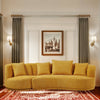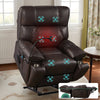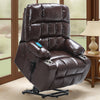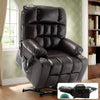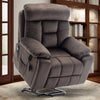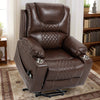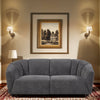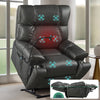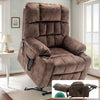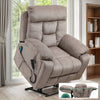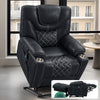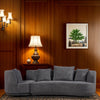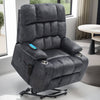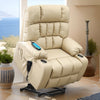Understanding the Appeal of Sectional Modular Sofas for Elderly Living
The Benefits of Modular Design in Aging-in-Place Strategies
Sectional modular sofas offer great benefits for aging-in-place strategies. They allow for easy reconfiguration as needs change. This flexibility is key for seniors who want to stay in their homes longer.

Modular designs can adapt to different room layouts. This is helpful if mobility needs change over time. Seniors can easily add or remove sections to suit their comfort levels.
These sofas often come with features like lift mechanisms. This can be a game-changer for those with limited mobility. It makes getting up and sitting down much easier and safer.
Modular sofas can also include storage options. This helps keep living spaces tidy and clutter-free. It's especially useful for those downsizing or with limited space.
How Sectional Modular Sofas Enhance Comfort and Accessibility
Sectional modular sofas are designed with comfort and accessibility in mind. They often have features that cater to the needs of the elderly.
Many models come with reclining sections. These allow seniors to find the perfect position for relaxation or sleep. Some even have power recline features for easy adjustment.
Wide, supportive armrests are common in these designs. They provide stability when sitting down or standing up. This can greatly reduce the risk of falls.
Modular sofas can be arranged to create easy pathways. This is crucial for those using walkers or wheelchairs. It ensures the living space remains accessible and safe.
Upholstery options often include easy-to-clean fabrics. This is important for maintaining hygiene, especially for those with incontinence issues.
Key Considerations When Selecting Sectional Modular Sofas for the Elderly
Evaluating Materials and Construction for Durability and Maintenance
When choosing a sectional modular sofa for the elderly, durability is key. Look for sturdy frames made of hardwood or metal. These will withstand daily use and provide stability.

High-density foam cushions offer the best support and longevity. They maintain their shape and comfort over time. This is important for seniors who may spend long hours sitting.
Consider upholstery materials carefully. Leather is durable and easy to clean. However, it can be cold to the touch. Microfiber is soft and warm, but may require more frequent cleaning.
Look for reinforced seams and quality stitching. These details ensure the sofa will hold up well over time. They also prevent tearing or unraveling, which can be safety hazards.
Choose sofas with removable, washable covers if possible. This makes maintenance much easier. It's especially helpful for dealing with spills or accidents.
Importance of Ergonomics: Finding the Right Fit for Your Elderly Loved Ones
Ergonomics plays a crucial role in selecting the right sectional modular sofa for seniors. The right fit can greatly improve comfort and prevent health issues.
Seat depth is an important factor. It should allow the user to sit back fully with feet on the floor. This promotes good posture and reduces strain on the back.
Seat height should allow for easy standing and sitting. Too low can make it difficult to get up. Too high can put pressure on the backs of the thighs.
Look for sofas with firm, supportive cushions. These help maintain proper posture and reduce fatigue. Avoid overly soft cushions that can be hard to get out of.
Armrests should be at a comfortable height for support. They should allow for natural arm positioning when seated. This reduces shoulder and neck strain.
Consider models with adjustable headrests. These can provide customized neck support. This is especially helpful for those with neck or upper back issues.
Installation and Maintenance: Ensuring Longevity for Your Sectional Sofa
Best Practices for Assembly and Placement in Elderly Care Settings
When installing a sectional modular sofa in an elderly care setting, careful planning is essential. Start by measuring the room and doorways. Ensure the sofa will fit and allow for easy movement.

Consider the layout of the room. Place the sofa where it's easily accessible. Avoid putting it too close to walls or other furniture. This ensures there's enough space for mobility aids.
During assembly, follow the manufacturer's instructions closely. Use all provided hardware and tools. This ensures the sofa is stable and safe for use.
If the sofa has power features, make sure outlets are nearby. Avoid using extension cords as they can be tripping hazards. Consider hiring professionals for installation if needed.
Test all functions after assembly. Make sure recliners, lift mechanisms, and other features work smoothly. Address any issues before the sofa is put into regular use.
Routine Maintenance Tips to Keep Your Modular Sofa in Peak Condition
Regular maintenance is key to keeping a sectional modular sofa in good condition. Start with daily light cleaning. Use a soft brush or vacuum to remove dust and debris.
For fabric upholstery, treat spills immediately. Blot, don't rub, to prevent spreading. Use appropriate cleaning solutions for different types of stains.
Leather sofas should be wiped down weekly with a damp cloth. Use a leather conditioner every few months to prevent cracking and maintain softness.
Check and tighten any loose screws or fittings regularly. This prevents wobbling and ensures the sofa remains stable and safe.
For sofas with mechanical parts, like recliners or lift chairs, lubricate moving parts as needed. This keeps them working smoothly and prevents wear and tear.
Rotate cushions regularly to ensure even wear. This helps maintain comfort and extends the life of the sofa. Fluff back cushions to keep their shape.
Consider professional cleaning once a year. This deep clean can remove embedded dirt and refresh the sofa. It's especially important for heavily used pieces.







